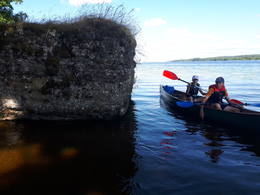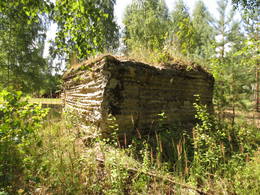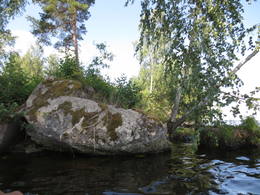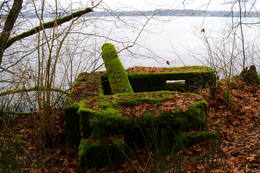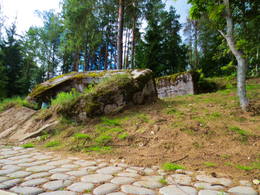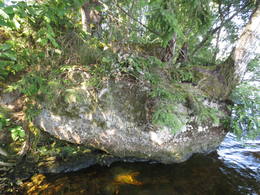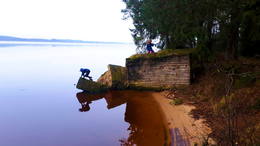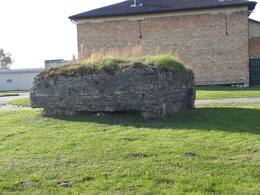Efforts to prevent the explosion of the Ķegums HPP
During World War II, when the armies retreated, a large number of militarily and logistically important facilities in Latvia were blown up so that these resources would not be left for the enemy. Such facilities were also in the vicinity of Ķegums, where one of the most important facilities is the Ķegums HPP, which, thanks to the efforts and efforts of its employees, was not completely destroyed.
I will tell you about that day as I have heard and as I have found out while collecting documents for the Kegums History Museum. There are some known facts, but there are also many unknown facts, which are unlikely to be fully clarified.
Knowing how the Germans blow up everything, this perspective was also clear to the people of Kegum. Even more so, when the guard unit, the Sonderkommando, stationed in Kegum, began to mine the bridge, the director of the Kegum HPP, Pāvels Krasovskis, and probably also his associates and associates, whose names we do not know, thought and actively worked to save the power plant as much as possible. Krasovskis had the entrance galleries under the dam walled up so that bombs could not be placed there. Being a hunter, he had gone to Sunāksti to hunt, although already in 1942 the German local government had refused to extend his permit to possess hunting weapons (a fact). But in fact, he supposedly met there with the men of the partisan unit led by Oškalns, with Samson. They supposedly agreed that in September Samson and his men would occupy Kegum, prevent the bombing and hold it until the Russians arrived. This plan was also known to the Russian army command. This is evidenced by the fact that while Russian aviation bombed all strategically important nodes, Ķegums was never attacked. And also the fact that on July 28, a landing party with the code name “Red Arrow” was dropped on the Tome side, which was probably supposed to cooperate with Samson in this operation. But the German espionage machine was also working, and in mid-September the landing party was completely destroyed within a few days. Krasovskis told his wife that Samson had not arrived at the appointed time. Samson says that he could not get to Ķegums due to betrayal... On September 16, Krasovskis was summoned to Riga to the superiors and arrested there (fact). On the same day, Osmanis, the father of the poet and writer Jāzeps Osmanis, Bērziņš and Giruckis, HPP workers, were also arrested in Ķegums. Krasovskis was transferred from Riga Central Prison to the Stutthof camp, then to the Sachsenhausen camp, where he died on February 12, 1945 (International Red Cross certificate). Osmanis apparently died on the way from Stutthof to Sachsenhausen. But Bērziņš was in the hospital at that time, then sent to Sachsenhausen, but on the way the Americans released him, and he, having recovered at home, worked at a power plant and died in 1978. After these arrests, the Sonderkommando was immediately changed. The very next day, on September 17, there was the first Russian air raid on Ķegums, and by then many had already left Ķegums. The White German Bētiņš was appointed director.
A few days before the Russian army entered (it happened on October 7), the Germans put their mines to work. Both long spans of the bridge were blown up, one segmental dam was blown up (but the concrete dam and earthen dams were intact!). All three generators in the engine room were blown up and then burned out, a bomb was placed in the fourth turbine, and two blades were torn off (this turbine can be seen in the Ķegums History Museum), the control room burned out. But the open-air distribution equipment was completely destroyed, not a single intact transformer, switch, measuring transformer, or support. A pile of scrap metal! And all this damage and the equipment had to be removed by the same Germans, now in the status of prisoners. Their bones still lie today in the territory of the Ķegums school stadium. The power plant was restored in three years.
Haunzems, H. 1996. "Daugava and us", pp. 57-58
Related timeline
Related objects
German army concrete fire point at the Ķegums HPP reservoir at the mouth of the Žega River
Located in the Ķegums HPP reservoir at the mouth of the Žegums River (opposite the Žegums House), on its left bank. One of the most visually and scenically impressive and also better preserved concrete fire points washed by the waves of the Daugava. It can be seen from a greater distance. A footbridge has been built from the shore to the top of the fire point (overgrown with grass). Narrow-gauge railway (?) tracks are built into the concrete walls of the fire point. You can enter it from the footbridge. This is one of the fire points of the German army's World War I defense line on the left bank of the Daugava, which can be more or less traced along the entire length of the left bank of the Daugava. The aforementioned defense line is a large-scale military system that has not yet been truly evaluated as a single entity. The remains of the fire point can be viewed by boating along the Ķegums HPP.
German army concrete fire point on the upper bank of the Ķegums HPP opposite Anduli
It is located about 1.2 km east of a small stream widening (the stream flows into Lejasgrantiņi) at the top of the steep bank slope of the Ķegums HPP opposite Anduļi. The bank in this place is overgrown with forest and undergrowth, so only a keen observer will notice this fire point from the side of the reservoir. The fire point is well preserved, as it has not been damaged by bank erosion. This is one of the fire points of the German army's World War I defense line on the left bank of the Daugava River, which can be more or less traced along the entire length of the left bank of the Daugava River. The aforementioned defense line is a large-scale military system that has not yet been properly evaluated as a single entity. The fire point can be viewed by boating along the Ķegums HPP, as it is located on private territory.
Remains of a German army concrete fire point in the Ķegums HPP reservoir opposite Sidrabiņi
Located about 0.25 km east of the Ķegums HPP reservoir bay near Silapūpēži, towards Jaunjelgava, opposite the Sidrabiņi farm. The fire point has partially sunk into the water and broken into several parts, resembling a pile of construction debris. The bank is overgrown. This is one of the fire points of the German army's World War I defense line on the left bank of the Daugava, which can be more or less traced along the entire length of the left bank of the Daugava. The aforementioned defense line is a large-scale military system that has not yet been fully evaluated as a single entity. The remains of the fire point can be viewed by boating along the Ķegums HPP. About 150 m west of the Daugava bank, the remains of another fire point have sunk into the water.
Remains of a German army concrete fire point at the Kegums HPP reservoir opposite Jaundauguļi
Located on the shore of the Ķegums HPP reservoir, about 0.6 km east of the Žega mouth, opposite Jaundauguļi. The fire point has slipped from the shore into the water and split into several parts. Two larger birches have grown into it, and a thicket has grown. One part of it is connected to the shore by a footbridge. This is one of the fire points of the German army's World War I defense line on the left bank of the Daugava, which can be more or less traced along the entire length of the left bank of the Daugava. The aforementioned defense line is a large-scale military system that has not yet been fully evaluated as a single entity. The remains of the fire point can be viewed by boating along the Ķegums HPP.
German army concrete fire point on the bank of the Ķegums HPP east of Lejasgrantiņi
It is located about 0.25 km east of the extension of a small stream (the stream flows into Lejasgrantiņi) on the slope of the Ķegums HPP bank. From the Jaunjelgava - Ķegums road (P85) it can be found by walking along the Daugava bank (overgrown, before that – a forest clearing). A careful observer will also notice it from the river, because during the summer there is lush vegetation here. The concrete parts of the fire point are covered with green moss, metal and wooden structures are visible in the opening. Since the fire point is located on the edge of a washed-out bank as a result of the wave action of the Ķegums HPP, it can be dangerous to visit. There is a deep pit (bomb pit?) nearby. This is the eighth (from the Ķegums HPP, towards Jaunjelgava) of the fire points of the German army's World War I defense line on the left bank of the Daugava, which can be traced more or less along the entire length of the left bank of the Daugava. The aforementioned line of defense is a large-scale military system that has not yet been truly evaluated as a unified whole.
German army concrete fire point on the banks of the Ķegums HPP near Puduri
Located on a peninsula at the mouth of the Konupīte River (now a flooded extension of the river) in the Daugava, in the territory of the Puduri recreation complex. As a result of wave erosion, the fire point has tilted towards the river. To prevent erosion of the banks, the banks of the reservoir are reinforced with a concrete protective wall. The fire points of the German army's defense line during the First World War can be traced more or less along the entire length of the left bank of the Daugava. The aforementioned defense line is a large-scale military system that has not yet been properly evaluated as a single entity. The fire point can be seen well when taking a boat trip along the Ķegums HPP.
Remains of a German army concrete fire point on the shore of the Ķegums HPP reservoir opposite Silapūpėžys
Located about 0.1 km east of the Ķegums HPP reservoir bay near Silapūpēži, towards Jaunjelgava. The fire point has partially sunk into the water, overgrown with trees, bushes and other vegetation, and to the uninitiated, from a greater distance from the water side, it may resemble a larger stone. One of the landmarks is a birch tree growing on it. This is one of the fire points of the German army's World War I defense line on the left bank of the Daugava, which can be more or less traced along the entire length of the left bank of the Daugava. The aforementioned defense line is a large-scale military system that has not yet been fully evaluated as a single entity. The remains of the fire point can be viewed by boating along the Ķegums HPP. About 150 m east of the Daugava bank, the remains of another fire point have sunk into the water.
German army concrete fire point on the banks of the Ķegums HPP near Pludinātijai
Located on a peninsula between Pludinātijai and the village of Latgali. As a result of wave erosion, the object has slipped from the shore slope to the current water level of the river. When the water level in the Ķegums HPP reservoir is higher, it is washed by the waters of the Daugava. When the water level is lower, it is completely dry. This is one of the fire points of the German army's World War I defense line on the left bank of the Daugava, which can be more or less traced along the entire length of the left bank of the Daugava. The aforementioned defense line is a large-scale military system that has not yet been fully evaluated as a single entity. The fire point can be seen well by taking a boat ride along the Ķegums HPP. The other option is to walk along a small path along the Daugava bank, which leads from the well-maintained beach “Spārītes”.
Remains of a German army concrete fire point at the Kegums HPP reservoir near Podnieki
Located in the Ķegums HPP reservoir, in a small bay, about 20-30 m from the Daugava bank opposite the Podnieki house. The outline of the fire point appears only when the water level in the Ķegums HPP reservoir is low. The rest of the time, they are under water and not visible. This is the third (from the Ķegums HPP, towards Jaunjelgava) of the fire points of the German army's defense line on the left bank of the Daugava during the First World War, which can be more or less traced along the entire length of the left bank of the Daugava. The aforementioned defense line is a large-scale military system that has not yet been fully evaluated as a single entity. The remains of the fire point can be viewed at low water level while taking a boat trip along the Ķegums HPP.
German army concrete fire point at Ķegums HPP (in the territory of the Energy Museum)
Located 300 m northwest of the Ķegums HPP dam (Ķegums avenue), in the territory of the Energy Museum. Relatively well preserved, visually impressive. Can only be viewed when visiting the Energy Museum, or from the north, on the other side of the fence of the Ķegums HPP territory. This is one of the firing points of the German army's World War I defense line on the left bank of the Daugava, which can be more or less traced along the entire length of the left bank of the Daugava. The aforementioned defense line is a large-scale military system that has not yet been truly evaluated as a unified whole.





